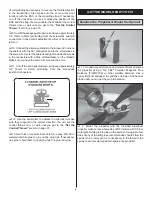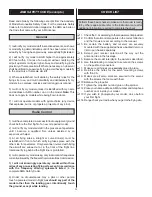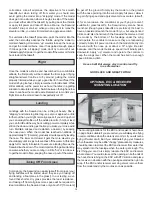
corrections. Like all airplanes, the objective is for smooth
takeoffs–but when taking off from water you should also
avoid getting the model into a “skipping” mode. If the model
does get into a situation where it begins to skip off the water,
you must either abort the takeoff by pulling back the throttle
or apply full power and takeoff. Once airborne, the Seawind
shouldn’t snap or stall, so while you may want to relax the
elevator a little, you can still maintain an aggressive climb.
To summarize the takeoff procedure: point the model into the
wind, then smoothly advance the throttle using the rudder to
maintain heading. Hold some “up” elevator to keep the nose up
and get the model airborne once it has gained enough speed.
If it does get into a “skipping” mode, don’t try to smooth it out.
Instead apply full power to get the model off the water or throttle
back to abort the takeoff.
Flight
Once the model is airborne and has climbed to a comfortable
altitude, the fi rst priority will be to adjust the trims to get it fl ying
straight-and-level. Continue to fl y around, getting the model
properly trimmed while you get a good feel for how it fl ies. If the
model is fl ying too fast, simply remember to throttle back. While
still at altitude, cut the power to see how it handles in a gliding
situation to simulate a landing. Switch between the high and low
rates to see how the model reacts. Remember to monitor your
fl ight time so the motor doesn’t unexpectedly cut off.
Landing
Landings with the Seawind can be a thing of beauty. She is
“slippery” and tends to glide long, so set your approach a little
farther out than you might normally expect–if you end up short
you can always throttle up. If the winds are calm (5 mph or less)
you can throttle all the way back cutting power completely while
still on the down wind leg just before you make your cross-wind
turn. Maintain airspeed and establish a descent by keeping
the nose down. When the model has reached an altitude of
approximately 10' [3 meters], gradually slow its speed by leveling
the nose. The lower and slower it gets the more elevator you
should apply until it is just a few inches off the water. At this time
apply full or nearly full elevator to execute a landing fl are as the
Seawind touches down. The most important thing about landing
on water–whether you are coming in a little “hot” or too slow–is
to get the model to fl are, keeping the nose up out of the water.
Taking Off From Grass
Surprisingly, the Seawind can easily takeoff from grass (your
fl ying buddies will be tickled when they see you taking off
and landing a fl oat plane in the grass!). In our testing, we’ve
found that shorter, dry grass provides the least resistance,
so if taking off from tall grass more space will be required. In
ideal conditions the Seawind took only about 50' [15 meters]
to get off the ground. Simply lay the model on the ground
with the nose pointing into the wind, apply full power, allow it
to gain fl ying speed and apply elevator to execute a takeoff.
If, for some reason, the conditions at your fl ying site aren’t
suitable for grass takeoffs, the Seawind may also be hand-
launched (though grass takeoffs are preferred). It’s best to
have an assistant launch the model for you, but experienced
pilots could also hand-launch the Seawind themselves. Hold
the model by the bottom of the fuselage under the wing
and operate the controls to make sure they are responding
correctly. Apply full power and launch the model directly into
the wind with the nose up at about a 30° angle. Be alert
because until the model builds up speed it will initially pitch
downward. Apply “up” elevator and operate the controls to
keep the wings level. When the model has built up enough
speed initiate a climb.
Have a ball! But always stay in control and fl y
in a safe manner.
GOOD LUCK AND GREAT FLYING!
OPTIONAL ESC & RECEIVER
MOUNTING LOCATION
The mounting locations for the ESC and receiver shown back
on page 8 are suitable if you are certain you will always be fl ying
in calm conditions when the water is smooth (or if you will not be
fl ying off water at all). But if you anticipate fl ying your Seawind
when the water may be a little “choppy,” precautionary measures
should be taken to protect the ESC and receiver from water that
may splash into the fuselage when the water gets rough. The
fi rst thing you can do is simply relocate the ESC and receiver
where shown. You could also seal the openings in both ends of
the heat-shrink tubing on the ESC with RTV silicone and place
the receiver in a balloon with the opening sealed with a nylon tie
wrap. If the ESC and/or receiver ever do get wet, remove them
from the model and dry them out as soon as possible.
15


































